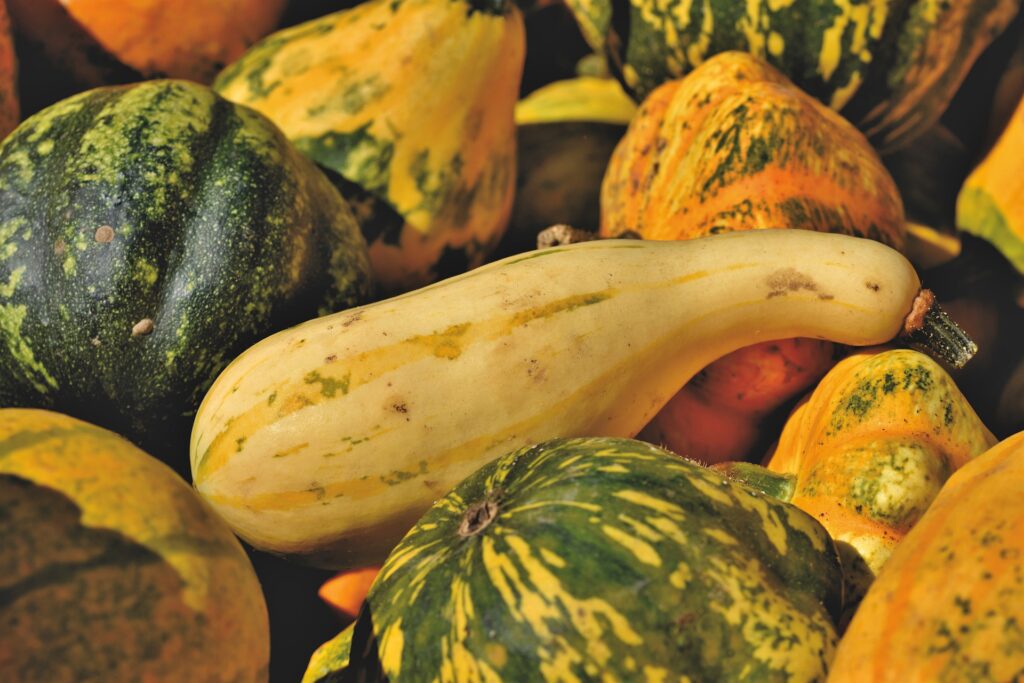Sponsored by Farm Credit of Central Florida
Celebrating Fall With Florida Pumpkins and Squash
by ERIKA ALDRICH
Fall is upon us, and that means it’s pumpkin and squash season. These members of the gourd family, called the cucurbit family, are synonymous with fall. Whether it’s a carved jack-o’-lantern flickering on the porch on Halloween night or the squash and pumpkin dishes that grace our tables this time of year, everyone knows that pumpkins and squash are signs of the fall season and its festivities. Explore the numbers when it comes to growing pumpkins and squash in Florida.
A Look at the Cucurbit Family
The cucurbit family includes watermelons, melons, cucumber, and luffa, the fibrous source of the loofah scrubbing sponge. It also includes those in the genus Cucurbita, which includes pumpkins, squash, and some gourds.
Pumpkins belong to one of four species: pepo, moschata, mixta, and maxima. Between the four species, pumpkins can grow into a range of sizes, anywhere from those measured in ounces to pumpkins weighing in at half a ton, according to the Agricultural Marketing Research Center (AgMrc). In the middle are those that fit the most conventional image of a pumpkin; the 5- to 25-pound range of pumpkins that can be used for carving jack-o’-lanterns, for decoration, or for processing for making perennial favorites such as pumpkin pie.
Pumpkins are nutrient-rich, offering generous levels of Vitamin A and Vitamin C, and a cup of cooked pumpkin has more potassium than a banana, according to AgMrc. Squash is also full of vitamins and minerals, like Vitamin A, Vitamin C, potassium, and more.
Squash is divided into summer squash varieties, like zucchini and yellow squash, and winter squash, such as butternut, acorn, spaghetti, buttercup squash. Whether a cucurbit is called a pumpkin or a squash is determined greatly in part by what region of the country you are in!
Pumpkin and Squash Production in Florida
Florida is the second-leading state in squash production behind California, according to AgMrc. Summer squash is mainly grown in the Miami-Dade region of Florida. According to UF/IFAS’s Extension EDIS publications, there are about 6,000 acres in the Miami-Dade area committed to growing summer squash to be sold nationwide for the winter fresh market. In 2017, the Florida Department of Agriculture and Consumer Services calculated the Total Production Value of Florida squash at $29.7 million, which is 17 percent of the total U.S. value. Winter squash is grown mainly in Florida’s west coast and South Florida regions.
Florida is not particularly well-known for its pumpkin production. However, pumpkins are grown in every state in the U.S., including Florida, as well as on every continent except Antarctica! According to UF/IFAS, “Howden” and “Jackpot,” are pumpkin varieties that grow well in Florida for jack-o’-lantern use. For those looking to grow pumpkins that can reach the 200-pound range, look to varieties like “Big Max,” “Big Moon,” and “Atlantic Giant.”
For those looking for something unique that grows in Florida’s heat and humidity really well, look to the Florida Seminole pumpkin. It’s a cultivar of Cucurbita moschata, and was grown by the Calusa, Creek, and Miccosukee peoples, according to UF/IFAS’s Gardening Solutions publication. These pumpkins are well-suited to Florida’s climate. While their appearance can vary, they generally look like a rounded pumpkin with a dull orange rind, and they have an inner flesh that tastes like a sweetened variety of butternut squash!


